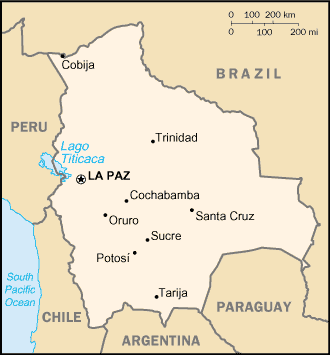Capital: Sucre (official capital, seat of judiciary); La Paz (seat of government)
Population: 8.8 million (UN, 2003)
Year of Independence: 1825, from Spain
Type of Government: Republic
GNP: $21.4 billion (2001 est.)
Natural Resources: tin, natural gas, petroleum, zinc, tungsten, antimony, silver, iron ore, lead, gold, timber, hydropower
Political Parties: Bolivian Socialist Falange (FSB); Civic Solidarity Union (UCS); Conscience of the Fatherland (CONDEPA); Free Bolivia Movement (MBL); Movement of the Revolutionary Left (MIR); Movement Toward Socialism (MAS); Nationalist Democratic Action (ADN); Nationalist Revolutionary Movement (MNR); New Republican Force (NFR); United Left (IU)
note: the ADN, MIR, and UCS comprise the ruling coalition
Bolivia is one of two landlocked countries in South America. (Paraguay is the other.) Much of the country is composed of high, desolate mountains and plateaus in the west, while the lower eastern valleys, called yungas, are tropical rain forests. Bolivia’s material wealth comes primarily from minerals — chiefly tin — found high in the eastern and northern mountains. The nation has the highest proportion of indigenous people in South America — roughly two thirds of its population. Nevertheless, the European-descended minority controls political, economic, and social power. Bolivia is one of the poorest countries on the continent; many of its people live on subsistence farming. Specifically, coca — the crop used to make cocaine — is a staple harvest for many. Government-sponsored eradication programs begun in the late 1990s have left coca-dependent areas impoverished. Other important agricultural products include coffee, cotton, soybeans, and sugarcane. Since independence, Bolivia has experienced nearly 200 revolutions and coups. The country’s current president, Gonzalo Sánchez de Lozada, is a millionaire and owner of Bolivia’s largest mining group; he also served as president between 1992 and 1997.



